terminology
[Huge thanks to Steve Sharik for getting a lot of this for me]
He's got nickel down. Also Sam, Rover, Money, Jaguar, Tractor, Dog, Pup, Cat, Bandit, Greyhound, and Aardvark. Read on to find out which two of those are not actually Don Brown positions that Peppers will play. [Bryan Fuller]
We had some bona fide MGoDudes attend the coaching clinic and the open practice in Florida, and they've reported back with a wealth of information about the new Michigan defense.
Coach Steve Sharik is writing up a full feature on it for HTTV, and in the course of editing that we went through all of the standard (and some of the non-standard) positions and terminology. I thought that would be extremely valuable to those of us trying to parse the coachspeak all spring, and figure out exactly what position various Guys and Dudes and whatnot are playing.
This week I thought I'd tackle the 4-man fronts that Michigan will run as their base defense. Brown also has myriad 3-man fronts (whence Winovich) that I'll get into next week.
Here are the two basic 4-man, or as Brown calls 'em, "70" fronts: 71 and 72.
These two alignments we'll see most of the time on standard downs, with personnel changing based on what the offense has in there. If you didn't spot the difference between 71 and 72, it's how the nose and end are aligned. In the first the nose is over the center (a 1-technique) and the end is in a 5-technique off the weakside OT. In 72 those guys have shifted over some, putting the nose over the guard (2-technique) so the end can split out wider. The first is stronger against inside runs, the second gives the end an easier path to pass rush or play a zone read.
And here are the base positions:
Let's meet them.
[After the jump: What's an "A", what's the difference between a Sam, a Jaguar, and a Money, and what the hell is Peppers?]
Little boxes on the grid-iron, little boxes made of football players, little boxes for positions, little boxes some the same. There's a tall one and a short one and strong one and speedy one and they’re all made out of ticky tacky and they all seem much the same.
Football positions are things that fans learn very young. Everyone knows who the quarterback and running back and linebackers etc. are. But then coaches start talking, and like any expert they designedly do so with such abstruse and recondite specificity as to elicit from the lay audience a greater appreciation for the mysteries of the speaker’s craft and complexities of  the imbroglio of disagreements wherein than said audience might have been provisioned in elucidation—much like a writer who uses lots of SAT words to say "they’re being pretentious." Not that our coaches do this; Hoke’s staff is remarkably candid as coaches go.
the imbroglio of disagreements wherein than said audience might have been provisioned in elucidation—much like a writer who uses lots of SAT words to say "they’re being pretentious." Not that our coaches do this; Hoke’s staff is remarkably candid as coaches go.
Anyhoo, as with the penultimate sentence of the previous paragraph, more obscure lexemes, when understood, can communicate greater subtleties as well as pedantry. So that you too can cognize the nuances, or just sound like an insufferable know-it-all during the Spring Game (that’s what you're here for anyway right?), hither a glossary of Michigan’s various names, past and present, for eligible receivers; would that the Oxford was so concise.
Football allows four players of any type in the backfield ("backs") plus the two guys lined up on the extreme edges of the line ("ends") to be eligible receivers. A QB, RB, TB, HB, TB, WB, SB, FB, UB, YB, FL, Z, SR, or R is technically a back, while a TE, SE, X and Y are ends.
Quarterback (QB): Is an effin quarterback. Mr. Lewan would you kindly show the audience what this look li…
Eric Upchurch
Ah. The first quarterback at Michigan was on Team 2 (1880): Edmund Barmore, though Elnathan Hathaway played some QB as well. Why "quarter?" When the game was young they played a lot like rugby, with rushers and a goalkeeper and innings and such. The recognizable part of this was that the rushers (blockers) were meant to plow the way forward, and a couple of ballcarriers stood half-way back from that. When the line of scrimmage and downs were established teams lined up in a diamond behind the line with a quarterback, two half-backs, and a full-back. Here's Stanford doing something like that under Harbaugh if you can imagine Luck is lining up in front of the 40 yard line:
The story is more complicated and took half a century but if you look at this you can see why the quarterback got the ball first. Now imagine the two halfbacks are receiving a lot of lateral handoffs and speeding for the edges more often, while the guy all the way back is set to plow straight forward.
Running Back (RB) is Michigan’s current preferred term for the traditional (first appeared in 1880) Halfback (HB), though RBs can often include fullbacks, e.g. Running Backs Coach Fred Jackson. Scatback or Powerback are unofficial labels that refer to skillsets, i.e. backs who, respectively, might run around or through attempted tackles. Tailback (TB) is slowly becoming an anachronism which seems to have made it into Michigan’s lexicon with Bo’s arrival and left shortly after the 1997 season; Manus Edwards in 1998 is the last player to be listed as "TB" in the Bentley database. That database phased out Halfback in the '60s.
Superback (SB) generally means an RB/WR hybrid. Rodriguez threw it around in 2009 to essentially mean Carlos Brown when Brandon Minor was in there too. It makes more sense the way Pat Fitzgerald at Northwestern uses it to mean an RB who can split out to be a receiver, thus creating matchup problems for defensive coaches who prefer to 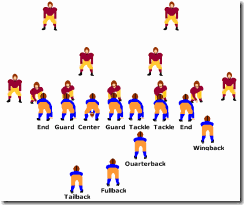 match personnel (one LB per backfield member, one DB per receiver). All-Purpose Back is something I think Rivals.com made up.
match personnel (one LB per backfield member, one DB per receiver). All-Purpose Back is something I think Rivals.com made up.
Fullback (FB) is now the misnomered blocking back.
An H-Back is a fullback/tight end hybrid. An H-Back will line up behind or outside a tackle and usually goes in motion before the snap. A Wingback (WB)—on the far right of the pic at right—is another anachronism from when Single-Wing and Wing-T formations ruled the game and passing was for communists and differs from the H- in that he's lining up outside the ends. Michigan has WBs listed from '69 through '79. This differs from an H-Back in that he lines up outside the tight end—this is Pop Warner-style with no receivers remember. An A-Back is another term for this.
Hoke's staff has been recruiting a position they call the U Tight End or more often just "U" which is almost indistinguishable from H- or A-Backs except that it's much closer to a tight end in the hybridization scale. Calling him an "end" is a misnomer because he's not on the line, therefore he's not any kind of end.
Smart Football, also linked on 11W's recent "Let's Bubble" article. I'm using it here to show how XYZ aren't always XYZ and what a 'U' is. Irony not lost.
You may remember the U from such Minnesota tight ends as those other Minnesota tight ends who were not Ben Utrecht or Matt Spaeth. Michigan did it too with Massaquoi and Ecker (right: from MGoBlue.com file, 2004). Nebraska has a U under Bo Pelini (Ben Cotton last year, Mike McNeill before) which he calls "The Adjuster" 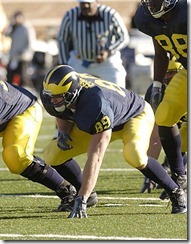 because he can be a FB, TE, or WR of the converted quarterback variety. Gruden calls this the "joker." In the play that had Greg Mattison cackling maniacally during the latest Spring Scrimmage overreaction you can see Ricardo Miller lined up as a U, which may be a nod toward more WR alleles this year, but Khalid Hill, a fullback-ian recruit, was offered at the 'U' and A.J. Williams came in as one too so Miller is not the coaches' ideal there.
because he can be a FB, TE, or WR of the converted quarterback variety. Gruden calls this the "joker." In the play that had Greg Mattison cackling maniacally during the latest Spring Scrimmage overreaction you can see Ricardo Miller lined up as a U, which may be a nod toward more WR alleles this year, but Khalid Hill, a fullback-ian recruit, was offered at the 'U' and A.J. Williams came in as one too so Miller is not the coaches' ideal there.
Also Syracuse used this position under Doug Marrone, which I only know this from scouring 'Cuse articles during various GERG-related panics. The thing about the U is you don't know where he'll line up (backfield or as a true TE) until after he breaks from the huddle, so it's kind of a personnel gimmick.
Tight End (TE) is normally an end who lines up flush with the tackles. They used to be just called "ends" before a distinction needed to be made between them and wide receivers; the last ends on Michigan's rosters—OEs to the Bump Elliott era—were phased out in the middle of the 1960s. To Hoke the typical tight end spot is the Y. This is where I would expect Ricardo Miller to line up, and where The Funchess and other more receiverish TEs will end up, since he has a clearer release to receive, and because he can line up flush or as a receiver (ends can't move before the snap).
That label comes from receiver nomenclature: X, Y, and Z. The letters come from reading across the formation most typical when receivers began needing special designations:
Wide Receivers (WRs) are backs and ends lined up outside the box. Having the Y move to the right turns him into the slot receiver. Having him split all the way out makes him a wide receiver. He also would then be outside the Z and screw this up, but NFL players seem to be able to keep straight who's who: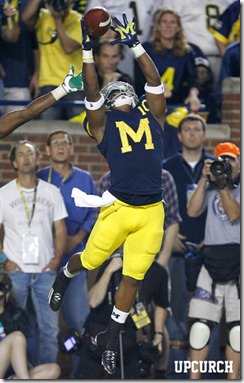
"Some teams, mostly in collegiate and high school football, use route trees and route numbers for play calls. So you might hear a play such as "Spread right, Z zoom, 821 H-swing on two." Knowing what you know now, the play call should make a lot more sense. Spread right is the alignment, Z zoom is the motion, 821 are the pass routes in the order of "XYZ." So X runs an 8, Y runs a 2, and Z runs a 1. H-swing tells you what the H man runs (the running back or often the "H" back in two tight end sets) out of the backfield."
It seems Y and Z don't care who lines up outside; Z is the one that has to line up at least a yard off the line of scrimmage and who's counted as a back. If you turn the fullback into a slot receiver on the other side or bunch him up or whatever, that receiver is the R.
Split End (SE) is the X and was where you'd normally put the 'No. 1' receiver. The nomenclature appeared on Michigan rosters with Bo and lasted a year longer than his career; Greg McMurtry was one of the last listed starters at "SE" in Bentley, although my 2003 program has Braylon as it. Michigan didn't really have a Braylon or McMurtry last year so this fell to Roundtree. As an end the X needs to get out of bump coverage but doesn't go in motion. The Z last year was mostly Junior Hemingway. This is the Flanker (FL) position, and is typically the Jason Avant to the SE's Braylon. That's what Roundtree means by doing more movement before the play; he's kind of the possession guy now; he has moved from an end position to technically a back.
This is where it gets confusing, because the Flanker or the Y or the R can both be the Slot Receiver (SR) or Slot Back. This is because the slot comes from spread formations which differentiate from slot and wide. The slot refers to the area on either side of the line about mid-way between the wide receiver and the tackles. If the FL is inside the Y, he's the slot. If the Z is inside, he's the slot. SR as an official roster position came and went exactly as quickly as Rich Rod did; the leftover guys like Gallon and Dileo are now, with the rest of the receivers, listed as WR.
As Borges, a West Coast guy, well knows, where the slot lines up matters much to the receiver in his area, since they will run routes off of each other to flood a zone or clog the lane for man defenders.
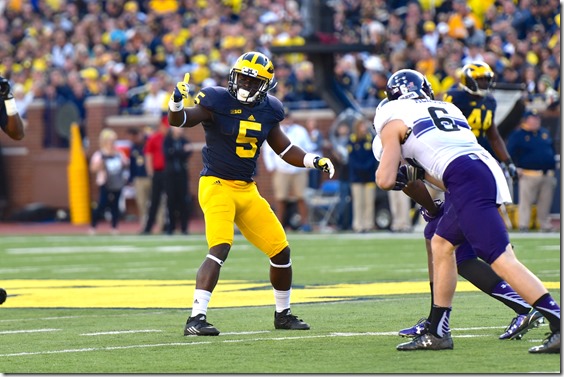
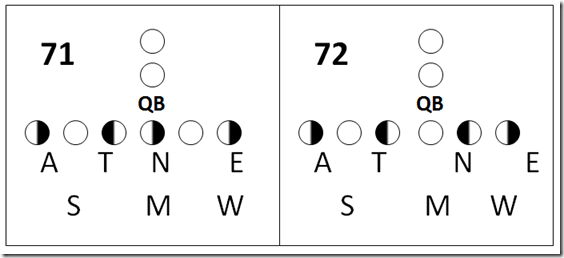

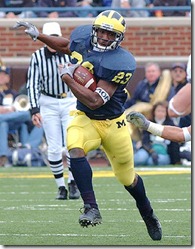
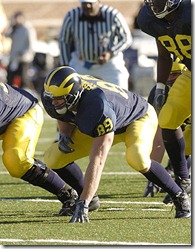
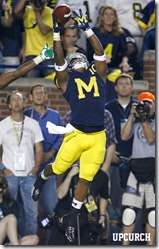

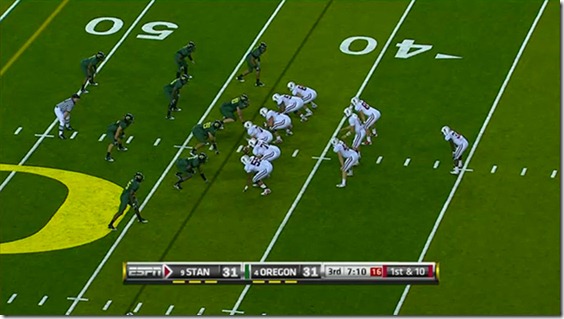
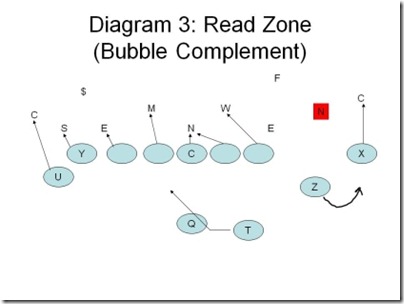
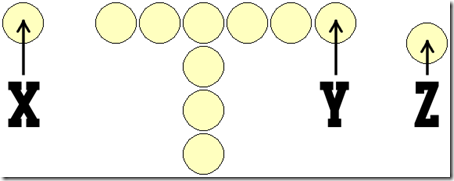
47